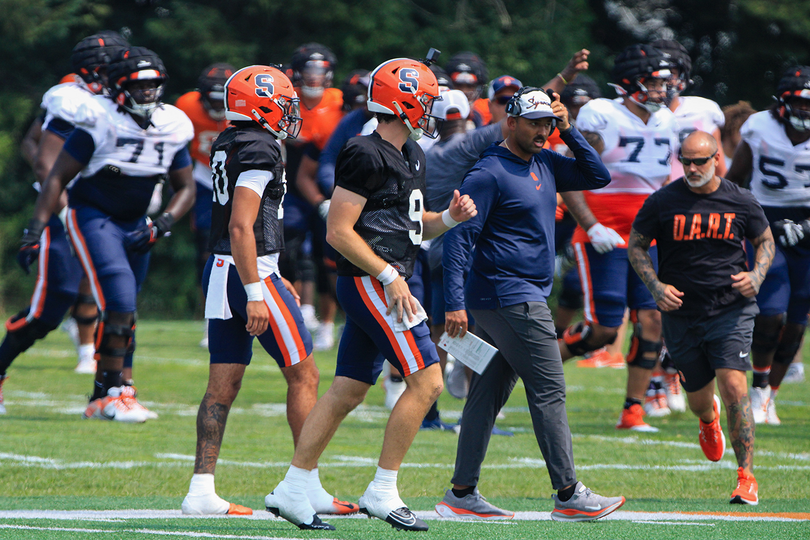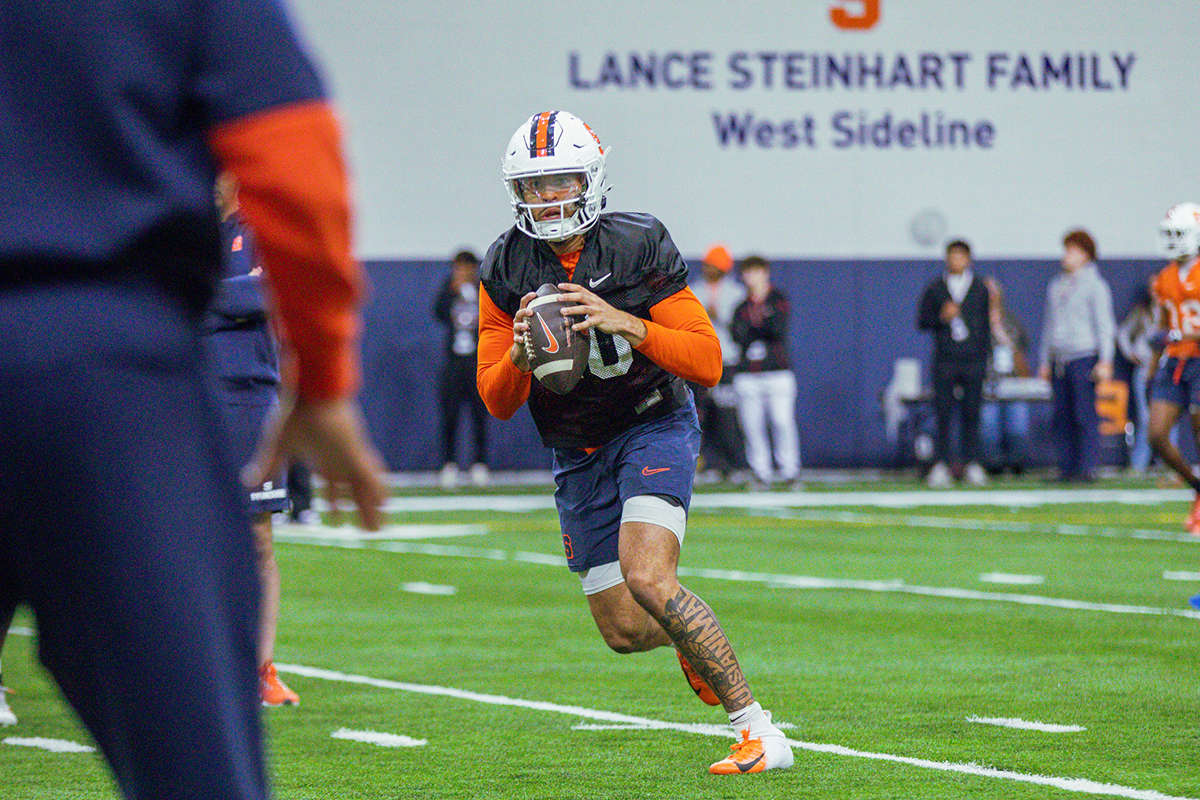The Orange sport 2 talented quarterbacks. Could they use both?

Despite choosing Steve Angeli as its starting quarterback, Syracuse may experiment with using Rickie Collins off the bench to supplement him. Angelina Grevi | Staff Photographer
Get the latest Syracuse news delivered right to your inbox. Subscribe to our sports newsletter here.
Syracuse opens its 2025 season on a national stage Saturday. The old adage goes: If you have two quarterbacks, you have none. That still might be true. But the Orange could test the theory despite naming Steve Angeli their starter.
Angeli enters the year as a career backup, starting just one game across his first three years at Notre Dame. LSU transfer Rickie Collins has seven pass attempts and seven carries through two college seasons in backup and third-string roles. SU head coach Fran Brown added Angeli in the spring transfer portal after naming Collins the starter. Brown then altered his game plan in fall camp, picking Angeli instead.
“Nothing’s ever set in stone that he’s our quarterback. He is. But things happen,” Brown said on Aug. 24 when explaining his decision to start Angeli. “That’s the present. But I don’t know.”
Ahead of a season where Syracuse doesn’t have an established starting quarterback, we examined what it’d look like if its offense involved both Angeli and Collins in their offense:
Nixon’s creativity allows for exploration
Brown sees Collins as one play away from being in the game. When meeting with both Angeli and Collins to tell them who would start Week 1, he mentioned the presence of backup Michael Johnson Jr. last season in support of Kyle McCord’s success. Collins losing the battle can be used more as an addition of resources than a pure demotion.
“Knowing that both of those guys are that close, it makes you just coach with a little bit of confidence, a little bit of freedom,” Brown said.
Under the direction of offensive coordinator Jeff Nixon, McCord played 1,032 total snaps in 2024 compared to Johnson Jr.’s 12, per Pro Football Focus. The discrepancy was nearly unheard of for a Syracuse quarterback, as McCord became its first signal-caller since Ryan Nassib in 2012 to start every game. However, Nixon has experience when the quarterback isn’t as sturdy.
His first year as co-offensive coordinator in 2017 at Baylor featured Zach Smith and Charlie Brewer splitting dropbacks with 227 and 253, respectively. The freshman Brewer took over for Smith after a few injuries and poor performances.
Brewer became the starter in 2018, but Nixon mixed in backup Jalan McClendon throughout the year. He finished with 715 passing yards and 102 on the ground and appeared in nine of Baylor’s 13 games. Oh, by the way, Brown was on that coaching staff in 2017 and 2018 as the assistant head coach to Matt Rhule.
Using Collins in running situations could be seen as an insult to his skill set due to his incredible throwing arm, which is probably better than Angeli’s. After all, both have been repeatedly separated by their peers based on distinct talents: Angeli is the better operator, and Collins is more talented.

Rickie Collins prepares to throw a pass in spring practice. Collins was named the starting quarterback in the spring but his spot was later taken by Steve Angeli. Angelina Grevi | Staff Photographer
Collins’ high school tape proves he’s electric in space and a freak athlete. Those abilities can be utilized and shouldn’t be wasted away on the sideline. Angeli was the Orange’s choice for Tennessee specifically, and they say they plan to stick with him. But who says Nixon doesn’t see a further-developed Collins as a better option by, let’s say, SMU in early October?
Examples of college teams using 2 QBs: What worked? What didn’t?
There’s no way of determining whether an offense that uses multiple quarterbacks works or not. We see teams who deploy two-QB systems, typically via a predominant passing arm splitting time with a rush-first quarterback and others who aren’t afraid to rotate starters throughout the year.
Exhibit A: the 2012 Northwestern Wildcats.
Former Northwestern head coach Pat Fitzgerald split snaps 50/50 between Trevor Siemian and Kain Colter. Siemian, a tall sophomore who worked best from the pocket, and Colter, a small, speedy junior who excelled on the ground, were an ideal yin and yang. Boasting an already strong running back room led by Venric Mark, Northwestern implemented a ground-and-pound attack, supplemented by Siemian dropping back to pass whenever it was necessary.
That season, the Wildcats went 10-3 and beat Mississippi State in the Gator Bowl, capping off one of the program’s best campaigns in modern history. They posted a top-20 rushing offense in the country, while Siemian threw for 1,312 yards to steady the Wildcats’ attack.
Sure, this is an extreme example to compare SU’s situation to. Siemian and Colter had vastly different playstyles. Though Angeli is a pocket passer and Collins is a dual-threat quarterback, they share more similarities than differences. Plus, there’s no way Nixon calls more run plays than pass plays.
Regardless, what Northwestern did with Siemian and Colter is the prime example of a team balancing two players’ best traits off each other. Maybe Syracuse could do the same.

Steve Angeli takes a break during summer camp. After being named Syracuse’s starting quarterback by Fran Brown, Angeli may be used in tandem with Rickie Collins similar to Northwestern’s strategy in 2012. Angelina Grevi | Staff Photographer
Just look at the 2021 Michigan Wolverines. The eventual Big Ten Champions that season started junior quarterback Cade McNamara throughout the year, yet highly-touted freshman J.J. McCarthy was featured in nearly every gameplan. McCarthy made 11 appearances in the Wolverines’ 14 games, tossing 516 yards and five touchdowns while running for 124.
This wasn’t a two-QB system but a sporadic rotation. McCarthy came into certain situations where he was thought to be a decoy. Though instead of making the mobile quarterback purely run zone-reads, he’d confuse defenses by tossing precise play-action passes.
Florida did something similar in 2006 with Tim Tebow and Chris Leak, rotating the uber-athletic Tebow in to give its offense a jolt. And we even saw last year’s Texas squad — which advanced to the College Football Playoff Semifinal — switch between well-established starter Quinn Ewers and redshirt freshman Arch Manning, who was typically used as a power-rusher in the red zone.
When things go awry in a two-QB system, though, it creates unsustainable dysfunction within an offense.
Take last year’s Florida squad, for example. After Week 1 starting quarterback Graham Mertz, a Wisconsin transfer, suffered a concussion, dual-threat freshman DJ Lagway started the Gators’ second game of the season. He threw for a UF freshman record of 456 passing yards to spur a 45-7 win over Samford. Yet, once Mertz got healthy for game three, Florida head coach Billy Napier made a puzzling decision to play both Mertz and Lagway against Texas A&M.
It didn’t work. The offense found no rhythm. Both quarterbacks were stagnant, registering QBRs of fewer than 50 points, while Lagway tossed two picks and Mertz threw one. Lagway wasn’t even a threat on the ground, rushing for -20 yards. The Gators lost 33-20 and quickly abandoned the strategy.
There are even times when players transfer due to inactivity within a two-QB system. In 2018, Georgia saw five-star freshman quarterback Justin Fields transfer after one season, getting a small share of snaps under center. He split time with Jake Fromm, who the Bulldogs retained as the starter the following season. But Fields wanted no part of another two-QB scheme.
If Syracuse has any inkling to use both Angeli and Collins, despite the former being named the starter, its plan will have to be sound so it can avoid playing quarterback musical chairs.
The modern landscape of playing 2 QBs
Within the new world of college sports, it’s important to remember Syracuse and its NIL contributors are paying for both Angeli and Collins, even if only one quarterback can see the field.
ESPN’s Max Olson reported that the rate for a “good” QB surpassed the $1 million mark in November. Multiple Power Four schools paid $1.5 million to pluck their starter from the transfer portal. Duke’s Darian Mensah and Miami’s Carson Beck, both newly minted ACC starters, are believed to be some of the highest-paid signal callers in the country.
The point? The Orange might play Collins to see both his current and future monetary worth. In other words, they need to see a return on their investment.
If SU opened up against Colgate instead of the No. 24 team in the country, it’s plausible to think it would allow the quarterback competition to spill over into Week 1. Mizzou, which opens against Central Arkansas on Thursday night, is doing just that. Penn State transfer Beau Pribula and junior Sam Horn will battle the Bears and each other, with head coach Eli Drinkwitz deciding the season’s starter after the game.
Former Syracuse head coaching candidate and current UNLV head coach Dan Mullen adopted a similar plan in Week 0 versus Idaho State. But it came with a twist that the Orange could follow. Michigan transfer Alex Orji began the game under center. But Virginia transfer Anthony Colandrea lined up on the outside. Colandrea motioned behind Orji presnap and received a flip, darting a ball incomplete down the right flank.
Both quarterbacks mixed in throughout the game for the Rebels, as Orji played 15 snaps with a rushing touchdown and Colandrea logged 58 with a passing touchdown. Both are balanced quarterbacks. But Colandrea is a better passer. And Orji is a better runner. Sound familiar? Both helped lead UNLV to a slight victory.
If Syracuse’s schedule had played out differently, it could’ve done the same. But it needed a prepared quarterback to face an SEC opponent for the first time in eight years. Hence, Angeli earns the start.






